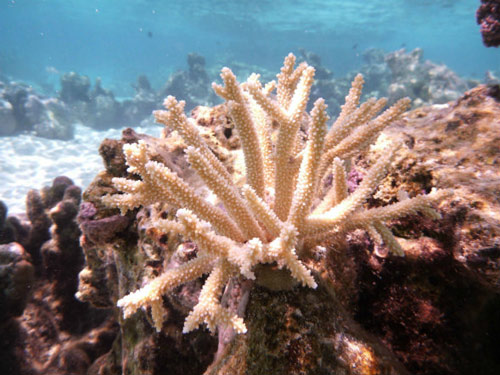San Diego State University researchers have discovered that humans and corals, two species about as different as you can get, share a 500-million-year-old biomechanical pathway responsible for triggering cellular self-destruction. The scientists say their finding (“Evolution of TNF-induced apoptosis reveals 550 My of functional conservation”), published in the Proceedings of the National Academy of Sciences, may help biologists to advance their understanding of the early evolution of multicellular life, conservationists to better understand the plight of modern corals, and medical researchers to develop new drugs to fight diseases like cancer.
Steven Quistad, a graduate student working in the lab of SDSU virologist Forest Rohwer, Ph.D., made the discovery earlier this year. While analyzing the proteins of the coral Acropora digitifera and matching them against human proteins, he found that both had receptor proteins that receive signals from tumor necrosis factor (TNF). When TNF proteins attach themselves to a cell’s TNF receptors, the cell begins to self-destruct. This process, also known as apoptosis, plays a crucial role in cellular health, allowing defective cells to destroy themselves before they can cause damage to the organism.
When Quistad looked more closely at the coral’s genome, he noticed that it had genes that coded for not just one TNF receptor, but 40 of them. The coral Quistad investigated had 14 different types of TNF and more TNF receptors than any other known organism on the planet. Humans, by comparison, have 25 TNF receptors.
The team then decided to expose the human version of a TNF protein to a coral’s TNF receptors to see what would happen.
“In response to human TNFα, coral cells underwent the classical stages of apoptosis including cellular blebbing, caspase activation, and eventual cell death,” wrote the investigators. “Next, the reciprocal experiment showed that coral TNF kills human cells through direct interaction with the death receptor pathway.…This work provides important insight into the general evolution of apoptosis and demonstrates remarkable conservation of the TNF apoptotic response.”
The findings suggest that the pathway by which TNF triggers apoptosis is old. “The fact that it goes both ways means that these domains haven’t changed in half a billion years,” Quistad said. “Corals are actually much more similar to humans than we ever realized.”
A better understanding of how TNF mediates apoptosis in coral might allow conservationists to identify more resilient species, and then reintroduce these hardier corals to places where coral loss is hurting the local ecosystem, noted Quistad, adding that preserving and learning from these corals is important for human health as well. By studying the various kinds of corals’ TNF proteins and TNF receptors, researchers might uncover medical properties useful for killing specific kinds of renegade cells, such as cancer cells.
“We have a lot to learn from corals about our own immune system,” said Quistad.



